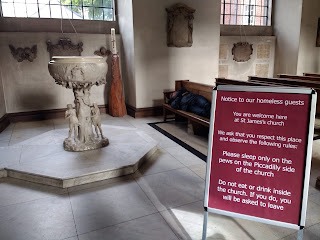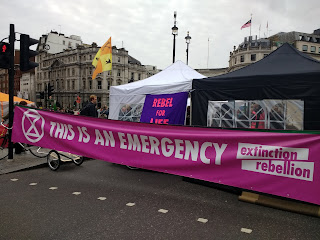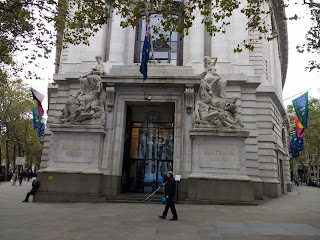Earlier, on the last day of our six-week trip to Ireland and the UK, Steven and I had a blast strolling some of London's most upscale shopping districts before arriving at St. Paul's Cathedral, England's national church located in The City area of London. Since 604 there had been a church on this spot. The symbol of the capital city's rise from the Great Fire of 1666 and of the city's survival following the 1940 Blitz, St. Paul's was also the location of famous weddings (think Prince Charles and Princess Diana) and funerals (think Prime Ministers Churchill and Thatcher.) Our first view of the 363-foot-high dome rising above the skyscrapers was jawdropping.
Near the baptismal font was a diamond-shaped plaque honoring those who fought so hard to save the landmark from destruction during the Second World War.
The immense dome just beyond the monument was painted with scenes from the life of St. Paul but it was just one of three. Looking up through the opening, we could see the light-filled lantern of the second dome. The last dome was only visible from outside and was made of lead-covered wood. The three-in-one dome was intentional so worshippers wouldn't feel awed by the tallest dome which was the second-largest one in the world when it was built.
The American Memorial Chapel commemorated the sacrifices of British and American people during WW II and especially the American servicemen whose names were recorded in the Roll of Honor. The tablet was unveiled by Queen Elizabeth II in November of 1958 in the presence of Vice President Nixon.
Thank you for accompanying us on this adventure from the comfort of your home. I hope you enjoyed seeing this part of the world through my lens and that you will join us on our next adventure! After the Ireland/UK trip, we left a month later in early November for "the trip of a lifetime" to Antarctica and then Patagonia and Paraguay but I've already blogged about that trip! In case you missed it here's the link to one of the Antarctica posts:
https://bergersadventures7.blogspot.com/2019/12/1118-nature-at-its-best-biuest-of-blue.html
Our plans this past spring were a four-month trip beginning on March 1st to parts of Asia and the Middle East we hadn't explored yet. Well, as everyone knows, the novel coronavirus stepped in and changed plans the world over. We were in southern India, just two weeks into the trip, when we had to rush home. Here's a link to one exciting day on our brief escape in Sri Lanka and India:
https://bergersadventures8.blogspot.com/2020/05/39-dambullas-dazzling-unesco-cave.html
We'd thought we'd come home from that trip in late June via San Francisco so we could meet our first grandchild who would have recently been born in the city by the bay. When we got home in mid-March, we began planning a road trip out to see our son, daughter-in-law, and their little angel, Max, in mid-June and then a very circuitous route home to Denver via the national parks in the Pacific Northwest! I'll start writing about the highlights within the week.
Now we've been home for two weeks, it's almost time for us to "hit the road" again as now we have a second granddaughter, Clara, who was born within seven weeks of her cousin! It looks like we'll be heading therefore to Chicago in two weeks so we can see that happy family on our way to the Florida panhandle where we made reservations last September to rent a cabin in a state park. While in the southeast US until mid-October, we'll be making several side trips throughout the region so stay tuned if you want to follow us to the beach and to some state capitals! Steven and I wish you good health and some of your own adventures in the next few months. Please stay safe.
The statue in front was of Queen Anne as she was on the throne when the church, designed by Christopher Wren, was finished in 1710.
The facade on the pediment told the story of St. Paul's conversion.
When we entered the nave, we had a distinct sense of how big St. Paul's was as it was the fourth largest in Europe after those in Rome, Sevilla, and Milan. It was amazing to think this was the first church of its size finished in the lifetime of its architect - it was built between 1675 and 1710.
Near the baptismal font was a diamond-shaped plaque honoring those who fought so hard to save the landmark from destruction during the Second World War.
Our visit to the church would have been enhanced if we'd been able to hear the organ.
Wellington's Monument was dedicated to Napoleon's conqueror at the 1815 Battle at Waterloo. The church was packed with 13,000 fans at his funeral!
Imagine the young Lady Diana Spencer walking up this very long aisle to meet her prince in 1981!
The immense dome just beyond the monument was painted with scenes from the life of St. Paul but it was just one of three. Looking up through the opening, we could see the light-filled lantern of the second dome. The last dome was only visible from outside and was made of lead-covered wood. The three-in-one dome was intentional so worshippers wouldn't feel awed by the tallest dome which was the second-largest one in the world when it was built.
The decision to hire Wren to design St. Paul's, as well as a new city around it including 50 other churches, was a little odd given that he was a 31-year-old astronomy professor and not an architect! However, he was known for his brilliance and a singular ability to work with others. He oversaw every aspect of the church's construction for over 40 years and, at the age of 75, was able to see his son place the cross atop the dome outside.
The dome weighed 65,000 tons and would have cost more than an astounding $850 million bucks in today's money! Granted, it was stunning as I remarked but it's hard for me to think any dome is worth that amount of money.
The sweet Mother & Child statue was created by Henry Moore, possibly the world's best sculptor. The work was inspired by images of British women nursing their infants in WW II bomb shelters as the city and church were heavily bombed by the Luftwaffe.
In the center of the church was the choir area which was standard for most British churches.
Another view of the choir:
The high altar sat under a large canopy decorated with corkscrew columns that, though it appeared ancient, only dated from 1958 as the canopy had to be rebuilt after it was damaged in October of 1940.
The mosaic ceiling also had to be rebuilt as did the American-themed stained-glass windows. If you click on the photos of the windows to make them larger, you may notice the American eagle, George Washington, and symbols of all 50 states. At first thought, that may seem unusual unless you remember that 28,000 American servicemen and women based in Britain paid the ultimate sacrifice during the war.
The American Memorial Chapel commemorated the sacrifices of British and American people during WW II and especially the American servicemen whose names were recorded in the Roll of Honor. The tablet was unveiled by Queen Elizabeth II in November of 1958 in the presence of Vice President Nixon.
Down in the center of the crypt was the tomb of Admiral Horatio Nelson (1758-1805) who defeated Napoleon off the coast of Spain as he prepared to invade the island from across the Channel.
The crypt also contained tombs and memorials of famous painters (Turner and Reynolds), of Florence Nightingale, and George Washington although he was buried in Virginia.
The simplest memorial belonged to Wren himself - a black slab but nary a statue.
Next to it was a large Portland stone as that was used to build St. Paul's. On one end we noticed Wren's triangle brand.
Just steps away from the monumental cathedral was Paternoster Square headed by this stunning gate that was built in 1672 of stone by St. Paul's architect, Wren, and which stood a half-mile west until 1878. The gate was dissembled and adorned a brewery owner's home until 2004 when the 2,700 stones were returned to The City and rebuilt here.
From the square, we had spectacular views of the dome. Perhaps one day if we're lucky enough to visit London and St. Paul's Cathedral again, we'll actually climb the magnificent dome.
Both of us smiled when the last photo of Steven on our amazing trip through Ireland and a small part of the UK was of him touching the sheep's butt on the Shepherd and Sheep statue in the square!
The last photo of our amazing trip to Ireland, Northern Ireland, north Wales, a small part of central England, and exploring family roots in Scotland was taken that night overlooking a canal near our London rental.
Thank you for accompanying us on this adventure from the comfort of your home. I hope you enjoyed seeing this part of the world through my lens and that you will join us on our next adventure! After the Ireland/UK trip, we left a month later in early November for "the trip of a lifetime" to Antarctica and then Patagonia and Paraguay but I've already blogged about that trip! In case you missed it here's the link to one of the Antarctica posts:
https://bergersadventures7.blogspot.com/2019/12/1118-nature-at-its-best-biuest-of-blue.html
Our plans this past spring were a four-month trip beginning on March 1st to parts of Asia and the Middle East we hadn't explored yet. Well, as everyone knows, the novel coronavirus stepped in and changed plans the world over. We were in southern India, just two weeks into the trip, when we had to rush home. Here's a link to one exciting day on our brief escape in Sri Lanka and India:
https://bergersadventures8.blogspot.com/2020/05/39-dambullas-dazzling-unesco-cave.html
We'd thought we'd come home from that trip in late June via San Francisco so we could meet our first grandchild who would have recently been born in the city by the bay. When we got home in mid-March, we began planning a road trip out to see our son, daughter-in-law, and their little angel, Max, in mid-June and then a very circuitous route home to Denver via the national parks in the Pacific Northwest! I'll start writing about the highlights within the week.
Now we've been home for two weeks, it's almost time for us to "hit the road" again as now we have a second granddaughter, Clara, who was born within seven weeks of her cousin! It looks like we'll be heading therefore to Chicago in two weeks so we can see that happy family on our way to the Florida panhandle where we made reservations last September to rent a cabin in a state park. While in the southeast US until mid-October, we'll be making several side trips throughout the region so stay tuned if you want to follow us to the beach and to some state capitals! Steven and I wish you good health and some of your own adventures in the next few months. Please stay safe.


























































































































































